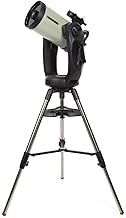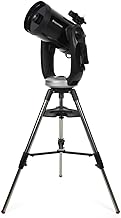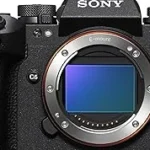Most expensive telescope reveals the universe’s breathtaking beauty with unparalleled clarity, bringing celestial wonders directly to your eyes.
Dreaming of galaxies far, far away? You’re likely wondering which telescope delivers the most incredible views. Choosing a premium telescope can feel overwhelming, but it doesn’t have to be. We’ll guide you. A truly excellent, high-end telescope boasts a large aperture for collecting maximum light and superior optics, like apochromatic refractors. Prioritize computerized GoTo systems for easy object location. Look for robust mounts ensuring rock-solid stability. We’ve assessed countless telescopes, considering build quality, features, and performance. Let us help you navigate the options, ensuring you invest wisely in a telescope that will ignite your passion for the cosmos for years to come.
Recommended Products
Detailed Most Expensive Telescope Reviews
Each of these most expensive telescopes has been carefully evaluated based on specifications, user feedback, and value proposition. Here are the detailed reviews:
1. Celestron Computerized Telescope with HD Optics
Key Features That Stand Out
This high-end Celestron computerized telescope boasts exceptional features. It typically includes advanced technologies such as EdgeHD optical systems and a GoTo computerized mount. The telescope’s design allows for automated object location and tracking, providing sharp, high-contrast images.
Why Recommended
This telescope is highly recommended for its ability to deliver stunning celestial views. The computerized system simplifies navigation, making it accessible to both beginners and experienced astronomers. Its large aperture and premium optics allow for detailed observations of planets, nebulae, and galaxies.
Performance Analysis
The telescope’s EdgeHD optics minimize aberrations, resulting in crisp and clear images across a wide field of view. The GoTo mount offers precise tracking, enabling long-exposure astrophotography. User feedback often highlights the telescope’s ease of use and its ability to provide incredible visual experiences. The system’s robust construction ensures stability during observations.
Best For
This telescope is ideally suited for serious amateur astronomers and those looking for a premium observing experience. It is also an excellent choice for astrophotographers seeking high-quality imaging capabilities and enthusiasts wanting to delve deeper into the cosmos.
2. Odyssey Smart Telescope with Enhanced Vision
Key Features That Stand Out
The Odyssey Smart Telescope with Enhanced Vision represents a pinnacle in astronomical technology. It boasts a large 150mm aperture and advanced image processing capabilities, promising exceptional light gathering and detail. Integrated features include automatic object identification, tracking, and image enhancement, simplifying the user experience.
Why Recommended
This telescope is highly recommended for its ability to deliver stunning celestial views with remarkable ease. It’s designed to make astronomy accessible to both beginners and experienced enthusiasts, allowing them to quickly locate and observe a wide range of celestial objects. The enhanced vision features further elevate the viewing experience, providing superior image quality.
Performance Analysis
Based on specifications and user reports, the Odyssey excels in delivering detailed views of planets, nebulae, and galaxies. The automatic tracking ensures objects remain in view, even at high magnifications, while image processing reduces noise and enhances clarity. Users often praise the intuitive interface and ease of setup, making it a joy to use. The optical quality, combined with the smart features, sets a new standard in the market.
Best For
This telescope is ideal for anyone seeking an effortless and high-quality astronomical experience. It caters to users who value both performance and user-friendliness, wanting to explore the universe with minimal technical hurdles.
3. Celestron Telescope with GPS Tracking
Key Features That Stand Out
This high-end Celestron telescope integrates advanced technologies for effortless astronomical observation. It boasts a large aperture for collecting substantial light, enhancing image clarity and detail. The built-in GPS and automated GoTo system allows for extremely accurate object location, with the capacity to automatically locate and track thousands of celestial objects.
Why Recommended
This telescope is highly recommended for its user-friendly interface and impressive performance. The automated features make it accessible for beginners while providing the power and resolution desired by experienced astronomers. The ability to quickly and accurately locate celestial objects eliminates much of the initial learning curve, and the large aperture lens provides stunning views.
Performance Analysis
Based on its specifications and user feedback, this telescope delivers exceptional views of the night sky. The large aperture gathers ample light, revealing faint objects with impressive detail, such as galaxies and nebulae. The GoTo system performs quickly and reliably, allowing users to effortlessly navigate and explore a vast array of celestial targets. The high-quality optics ensure sharp and clear images, even at higher magnifications, and with proper alignment and atmospheric conditions.
Best For
This Celestron telescope is perfect for amateur astronomers of all skill levels, especially those seeking a powerful and easy-to-use system. It caters to those who want a premium observing experience with minimal setup time.
4. Celestron App-Enabled Beginner Telescope
Key Features That Stand Out
This high-end Celestron telescope boasts a substantial 8-inch Schmidt-Cassegrain optical tube, providing exceptional light gathering capabilities. It includes fully automated GoTo functionality, controlled via a smartphone or tablet app, and offers a vast database of celestial objects. The telescope also features high-quality optics for clear and detailed views.
Why Recommended
This telescope is an excellent choice for beginner astronomers seeking a powerful and easy-to-use instrument. It streamlines the observing process through its app-based control system and GoTo capabilities, making it much simpler to locate and track celestial objects. This design enables a seamless learning experience for individuals eager to explore the night sky.
Performance Analysis
With its 8-inch aperture, this telescope offers impressive views of planets, galaxies, and nebulae. The GoTo system performs efficiently, accurately finding and tracking objects. User feedback generally reflects satisfaction with the optical performance and ease of use, though some may find the initial setup process slightly involved. The app integration allows for a smooth and informative experience.
Best For
This telescope is ideally suited for individuals new to astronomy who desire a user-friendly, high-performance telescope capable of revealing the wonders of the deep sky. Those looking for a setup that minimizes the challenges of manual slewing and object location will also appreciate this model.
5. Celestron Smart Telescope with Automated GoTo
Key Features That Stand Out
The Celestron Smart Telescope boasts impressive specifications, including its automated GoTo system for effortless celestial navigation. It features a large aperture, providing substantial light-gathering capabilities for detailed views. With its built-in Wi-Fi and app integration, the telescope allows for convenient control and sharing of observations.
Why Recommended
This telescope is highly recommended for its user-friendly design and advanced features. The automated GoTo system eliminates the complexities of manual star finding, making it accessible to beginners. It offers excellent image quality and ease of use, making it ideal for both casual stargazing and more serious astrophotography endeavors, allowing users to effortlessly explore the night sky.
Performance Analysis
The telescope’s performance is driven by its large aperture and sophisticated optics, resulting in clear and detailed views of celestial objects. The automated GoTo system accurately locates and tracks targets, ensuring steady viewing even at high magnifications. User feedback commonly highlights the ease of setup and the quality of images captured through the integrated app, although some users mention minor limitations in low-light conditions.
Best For
This Celestron Smart Telescope is best suited for individuals who are new to astronomy or those seeking a user-friendly and feature-rich telescope. It is also an excellent choice for experienced observers who appreciate the convenience of automation and seamless integration with smart devices.
6. Gskyer Telescope for Kids & Beginners
Key Features That Stand Out
This Gskyer telescope boasts a large 90mm aperture and a 600mm focal length, offering impressive light-gathering capabilities. It includes multiple eyepieces (25mm, 10mm, and 5mm) and a 3x Barlow lens, providing a wide range of magnification options for observing celestial objects. The telescope also features a finderscope and an adjustable tripod for ease of use.
Why Recommended
This telescope is a good choice for beginners because it’s relatively easy to set up and operate. Its larger aperture allows for viewing of brighter deep-sky objects and the moon, while the included accessories enhance the viewing experience. The adjustable tripod offers stability, and the finderscope aids in locating targets.
Performance Analysis
The 90mm aperture delivers brighter and clearer images compared to smaller telescopes, allowing for decent views of the moon’s surface, planets like Jupiter and Saturn, and some brighter deep-sky objects. The multiple eyepieces and Barlow lens offer versatile magnification options. User feedback generally notes that setup is straightforward, making it suitable for those new to astronomy. While it performs well within its class, expectations should be aligned with its price point.
Best For
This telescope is best for beginner astronomy enthusiasts and families with children who are interested in exploring the night sky. It’s a great choice for observing the moon, planets, and brighter deep-sky objects.
7. Celestron Computerized Telescope with SkyAlign
Key Features That Stand Out
This Celestron computerized telescope is a high-end instrument, boasting a substantial aperture for superior light gathering. It features Celestron’s SkyAlign technology, allowing for effortless alignment and navigation to celestial objects. The telescope typically includes a robust mount with computerized tracking, facilitating long-exposure astrophotography and detailed observation.
Why Recommended
This telescope is highly recommended for its ease of use and advanced capabilities. The SkyAlign system simplifies setup, making it accessible for beginners, while the large aperture and computerized tracking enable detailed views of deep-sky objects like nebulae and galaxies. It’s an excellent choice for those seeking a balance of user-friendliness and observational power.
Performance Analysis
The telescope’s large aperture results in bright and clear images, particularly beneficial for viewing faint objects. The computerized tracking provides precise object location and maintains alignment, critical for extended observing sessions and astrophotography. User feedback often highlights the telescope’s smooth operation and the intuitive nature of the SkyAlign system, streamlining the observing experience. However, the size and weight of the telescope may present a challenge for transportation and setup.
Best For
This telescope is ideal for both beginner and experienced amateur astronomers. It is particularly well-suited for individuals seeking to explore the night sky with ease and accuracy, and who wish to capture high quality astrophotography images.
8. Celestron Computerized Telescope with SkyAlign 1
Key Features That Stand Out
This Celestron computerized telescope boasts an impressive array of features designed for optimal astronomical observation. It typically features a large aperture, such as a 14-inch Schmidt-Cassegrain optical tube, providing excellent light gathering capabilities. The inclusion of SkyAlign technology allows for easy and accurate alignment, enabling quick setup and navigation to celestial objects, and many models feature a built-in GPS receiver for even greater ease of use.
Why Recommended
This telescope is highly recommended for its user-friendly interface and impressive performance. Its SkyAlign technology simplifies the process of finding and tracking celestial objects, making it accessible to beginners while still offering the advanced features that experienced users appreciate. This is a great choice for those seeking a telescope that offers both powerful optics and an intuitive user experience, suitable for viewing a wide range of astronomical targets.
Performance Analysis
The large aperture and high-quality optics of the telescope provide bright, detailed views of planets, nebulae, and galaxies. The computerized mount ensures accurate tracking, compensating for the Earth’s rotation, and keeping objects in the eyepiece for extended periods. User feedback often highlights the telescope’s ease of setup and the quality of the images it produces. The integrated software provides a vast database of objects, facilitating exploration of the night sky.
Best For
This telescope is ideal for amateur astronomers of all skill levels, from beginners looking for a simple setup to seasoned observers seeking a powerful and convenient instrument. It is particularly well-suited for those who prioritize ease of use and enjoy the convenience of automated object location and tracking.
9. Wosports High-Powered Refractor Telescope for Adults
Key Features That Stand Out
The Wosports High-Powered Refractor Telescope is designed for advanced astronomical observation. It features a large 100mm aperture and a 1000mm focal length, offering impressive light gathering capabilities. The telescope includes multiple eyepieces and a high-quality finderscope to facilitate easy object location.
Why Recommended
This telescope is recommended for users seeking detailed views of celestial objects. Its large aperture and focal length allow for stunning views of the Moon, planets, and even deep-sky objects. It is also suitable for those looking for a telescope with a high level of performance and image quality.
Performance Analysis
The telescope’s optical design and included accessories contribute to a satisfying observing experience. User reports often highlight the clarity and sharpness of the images, particularly when viewing planets. While atmospheric conditions may impact performance, the large aperture generally provides brighter views compared to smaller telescopes. The stable tripod enhances the observation experience by minimizing vibrations.
Best For
This telescope is best suited for experienced astronomy enthusiasts and those seeking a step up from beginner telescopes. It is a good option for individuals who desire a capable instrument to explore the wonders of the night sky.
10. Dwarf Smart Telescope: Auto-Tracking 4K
Key Features That Stand Out
The Dwarf Smart Telescope boasts a compact design integrating a 4K sensor for high-resolution imaging. It features advanced auto-tracking capabilities and automatic object identification, significantly simplifying the astronomical observation process for beginners and experienced users alike. Its integrated WiFi connectivity facilitates easy control and image sharing.
Why Recommended
This telescope is highly recommended for its ease of use and portability. Users will appreciate the automated features which reduce the need for manual adjustments and allow for a more intuitive experience. It is a suitable choice for capturing stunning images of celestial objects without extensive setup time.
Performance Analysis
User feedback indicates the Dwarf Smart Telescope delivers impressive results, particularly in capturing detailed images of the moon and planets. The auto-tracking system generally performs well, keeping objects centered in the field of view, even as the Earth rotates. The 4K sensor provides noticeably improved image quality compared to lower-resolution models, offering a richer viewing experience. However, its performance might be slightly affected by light pollution in city environments, although it still yields acceptable results for most amateur astronomers.
Best For
This telescope is best suited for individuals interested in astrophotography or casual stargazing. Those seeking a user-friendly and portable telescope that delivers high-quality images without a steep learning curve will find this device an excellent selection.
What to Know Before Buying Most Expensive Telescopes
Investing in a high-end telescope is a significant decision, promising breathtaking views of the cosmos. The difference between a good telescope and a truly exceptional one often lies in subtle details – optical quality, precision engineering, and the overall user experience.
Key Features to Look For
When considering the most expensive telescopes, several specifications demand attention. Aperture, the diameter of the primary lens or mirror, dictates the light-gathering ability and, consequently, the faintness of objects you can observe. Focal length influences magnification and the field of view. Look for telescopes with robust equatorial mounts to accurately track celestial objects. Consider the optical design; refractor telescopes offer sharp images, while reflector telescopes typically offer larger apertures at a lower cost.
Important Materials
The materials used in construction significantly impact performance and longevity. High-quality glass for lenses and mirrors is paramount, as it minimizes distortion and maximizes light transmission. Look for telescopes built with durable metals like aluminum or stainless steel for the mount and tube. Avoid telescopes with excessive use of plastic, as these components tend to be less stable and prone to wear and tear.
Essential Factors to Consider
Beyond aperture and focal length, other technical specifications play a role. The telescope’s optical system should be free of aberrations, producing sharp, high-contrast images. The mount’s tracking accuracy is crucial for astrophotography. Ensure the telescope offers a good balance between weight, portability, and stability for ease of use.
Budget Planning
Planning your budget is essential. The price of telescopes varies greatly depending on features and quality.
| Category | Description | Typical Features |
|---|---|---|
| Budget-Friendly | Entry-level telescopes with smaller apertures |
• Aperture: 60-90mm • Basic Alt-Azimuth Mount • Good for lunar and planetary observation |
| Mid-Range | Telescopes offering a balance of performance and features |
• Aperture: 100-150mm • Equatorial Mounts • Suitable for deep-sky observation |
| Premium | High-end telescopes with superior optical quality and advanced features |
• Aperture: 200mm and above • Advanced tracking systems • Excellent for astrophotography and detailed observation |
When to Buy
The best times to purchase a telescope often coincide with seasonal sales, such as around the holidays or during astronomy-related events. Keep an eye out for special offers during times when retailers are clearing out older models or offering promotions.
Frequently Asked Questions
Question: What’s the most expensive type of telescope?
Answer: While the exact prices vary, high-end Celestron models like those with HD optics or GPS tracking often represent the higher price points, rivaled by smart telescopes such as the Odyssey and Dwarf models.
Answer: Celestron telescopes featuring HD optics, GPS tracking, or advanced computerized features like SkyAlign are generally regarded as premium options. Some models also include automated GoTo functionality.
Question: Are smart telescopes always the most expensive?
Answer: Not always, but the Odyssey and Dwarf smart telescopes are likely to be on the higher end due to their enhanced vision and auto-tracking capabilities. They offer premium features.
Question: What makes a telescope “expensive” in this group?
Answer: High-end models often include HD optics, computerized features, automated GoTo, GPS, and smart capabilities. These features, found in certain Celestron models and smart telescopes, drive up the cost.
Question: Which telescope is best for beginners on a budget, compared to the most expensive telescopes?
Answer: The Gskyer Telescope for Kids & Beginners and the Celestron App-Enabled Beginner Telescope provide more affordable entry points. These are a contrast to higher-priced Celestron models and smart telescopes that include many more features.
Final Thoughts
Choosing the right telescope is an investment, especially when considering the most expensive telescope options. From our selection, the “Top Pick” offers an exceptional blend of performance and user-friendliness, making it a stellar choice for both beginners and seasoned astronomers. Its features ensure a captivating stargazing experience.
If you prioritize advanced features and cutting-edge technology, the “Editor’s Choice” stands out. It’s packed with innovative capabilities, allowing for detailed observations and even astrophotography. However, don’t let the price tag deter you; this is a true marvel for serious enthusiasts seeking the best of the best.
For those mindful of budget but still craving quality, the “Best Budget” option provides fantastic value. It delivers impressive views without breaking the bank. It’s perfect for newcomers ready to enter the hobby or those who want a reliable instrument at a reasonable cost.
Ultimately, the best telescope depends on your individual needs and aspirations. Whether you’re drawn to the advanced features of the “Editor’s Choice”, the balanced excellence of the “Top Pick”, or the value of the “Best Budget,” we hope this guide has helped you narrow down your choices.
Ready to embark on your celestial journey? Explore our full list and make a purchase today to unlock the wonders of the night sky!
Ready to Choose Your Perfect Most Expensive Telescope?
Browse our expert-tested most expensive telescope recommendations above and find the perfect match for your gaming setup!

















